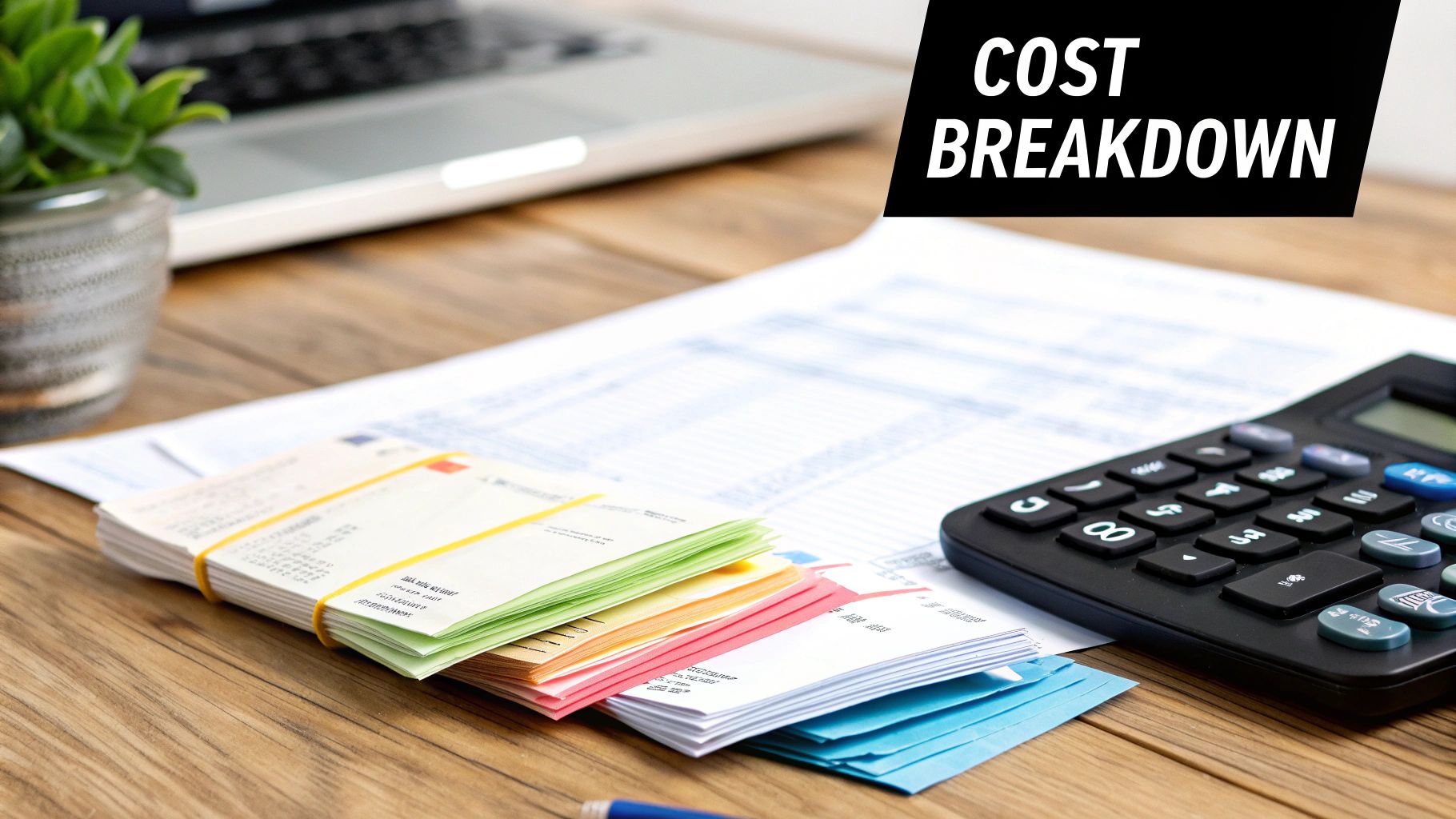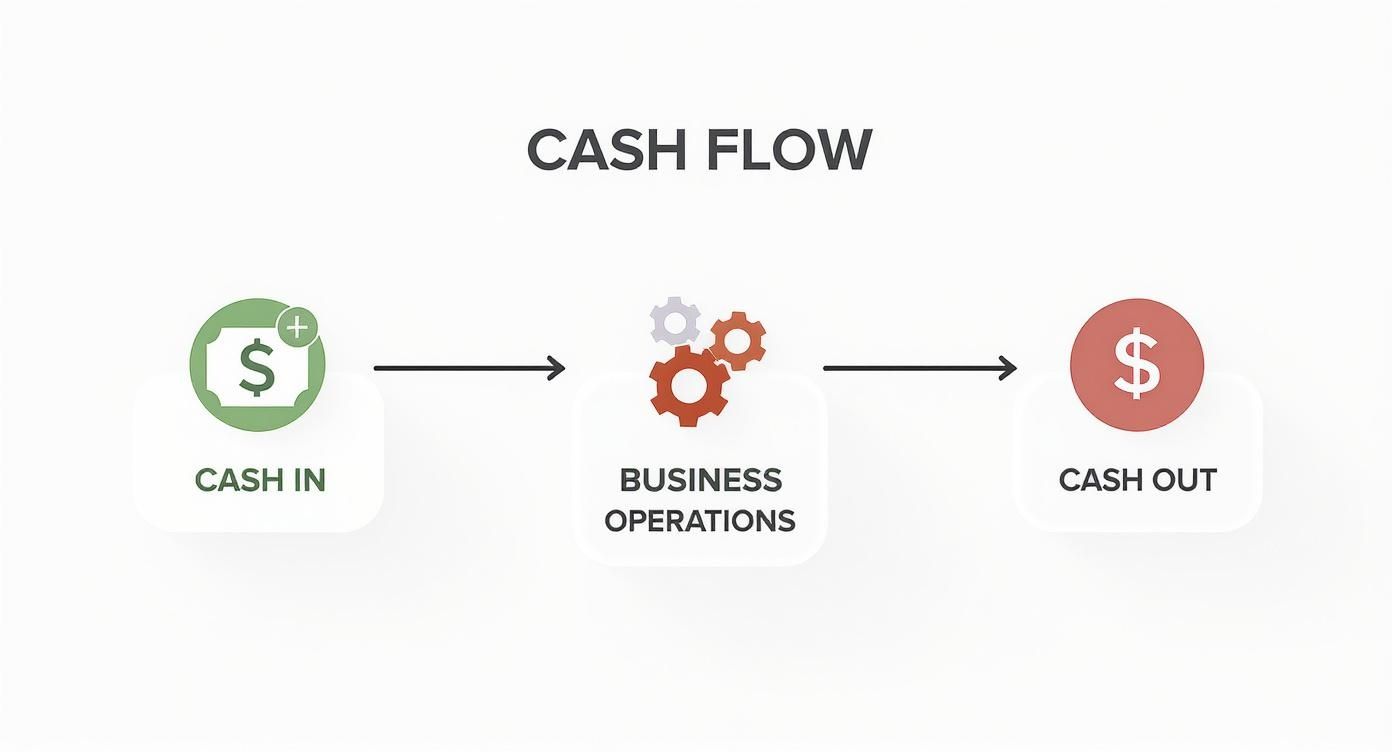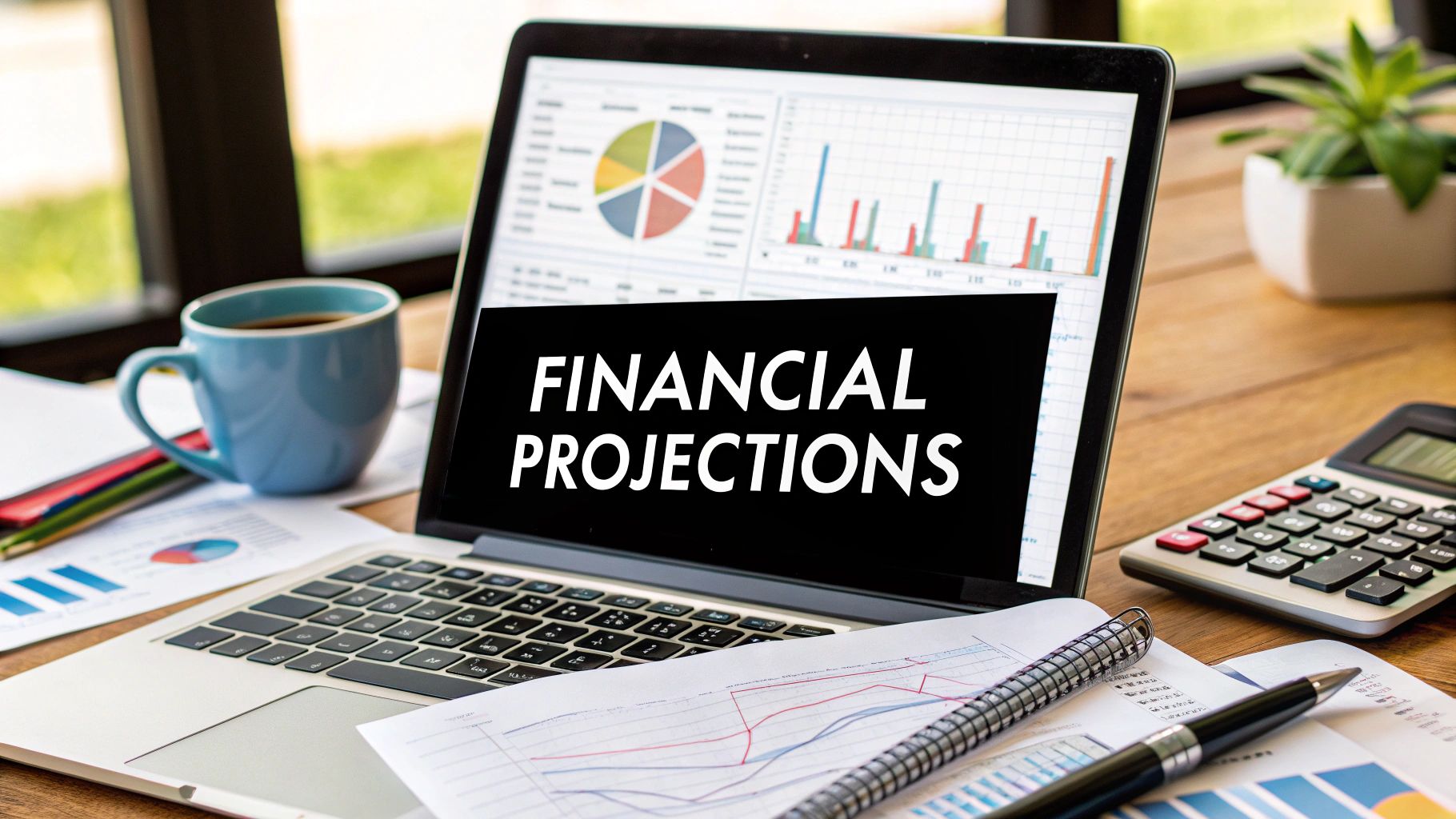Let's be honest, for many small entrepreneurs, diving into spreadsheets is the least exciting part of building a business. But your financial projections are where your business model meets reality. They take your brilliant idea and translate it into the language that investors and lenders understand: numbers.
This part of your business plan is built on three key documents—the income statement, the cash flow statement, and the balance sheet. Together, they tell the financial story of your business and prove it’s not just a passion project, but a truly viable company.
Why Financial Projections Are the Foundation of Your Business Plan

Think of your financial projections as the ultimate reality check for your business model. For a small business owner, it's less about being an accounting wizard and more about building a logical, convincing case for your future success.
These numbers are more than just a hurdle to clear for a loan application; they become your internal roadmap. They’ll guide your strategic decisions, helping you spot potential cash crunches or uncover growth opportunities long before they happen. In many ways, they are the financial proof behind your marketing plan and operational strategies.
Speaking the Language of Investors and Lenders
When you're asking for money, people want to see a clear path to getting it back—and then some. Your financial projections are the single most important tool for communicating that potential. A well-researched forecast shows you've done your homework and you genuinely understand your market, your costs, and your strategy for turning a profit.
"A business plan is the roadmap to your success. It should outline your business goals, strategies, and financial projections."
This numerical story answers the three make-or-break questions every potential backer has on their mind:
- When does the business actually make money? Your income statement lays this out.
- Will we have enough cash to keep the lights on? The cash flow statement is crucial for this.
- What's the company's net worth? The balance sheet provides this snapshot of overall financial health.
A Powerful Tool for Strategic Thinking
Beyond just securing capital, the act of building these projections forces you to get brutally honest about every part of your business model. You can't just pull sales figures out of thin air; you have to justify them with solid market research and a realistic marketing plan. The process is a lot like putting together a detailed feasibility study—you're testing if the plan is even practical for a small entrepreneur.
Just as you create forward-looking projections, it's incredibly helpful to know how to read company financial statements to analyze past performance. This skill grounds your assumptions in reality, making your forecasts far more credible and transforming abstract goals into a concrete, actionable plan.
Building Your Sales Forecast from the Ground Up

Your sales forecast is the absolute bedrock of your financial projections business plan. Think of it as the engine driving everything else. Every other number you run, from what you'll spend to your cash flow, all stems directly from what you project in sales.
For a new entrepreneur, staring at a blank spreadsheet and trying to predict the future can feel like a total shot in the dark. I get it. The trick is to pull it out of the realm of guesswork and anchor it in reality. The best way to do that is by using two different, yet complementary, methods.
By combining a "top-down" and a "bottom-up" analysis, you build a forecast that's not just a number, but a story. It shows you’ve thought about the big picture and the nitty-gritty details of how your marketing plan will actually generate sales.
Top-Down vs. Bottom-Up: Two Sides of the Same Coin
Let's break these down. A top-down analysis starts big. You look at the entire market you're entering and estimate what slice of that pie you can realistically grab.
For example, imagine the local market for gourmet coffee is worth $2 million annually. If you believe you can capture a modest 2% of that in your first year, your top-down forecast is $40,000. It's a useful high-level sanity check for your business plan.
A bottom-up forecast, on the other hand, is built from your own operational capacity. This is often far more tangible and, frankly, more useful for a new small business. You're not looking at the whole market; you're looking at what you can actually produce and sell.
Here’s how a freelance consultant or small entrepreneur might think it through:
- My Capacity: I can realistically juggle 4 clients at a time each month.
- My Rate: My average project fee is around $2,500.
- Monthly Forecast: That's 4 clients multiplied by $2,500, which gives me a $10,000 monthly sales projection.
See the difference? This method grounds your projections in what’s actually achievable for your business model. For a fantastic real-world example, check out this detailed financial projection sample for a coffee shop. It beautifully breaks down sales based on daily customer numbers and average spending per person.
Don't Just Show the Numbers, Show Your Work
A forecast is nothing without the assumptions that support it. Anyone reading your business plan—especially lenders and investors—will zero in on these. You absolutely have to document your thought process clearly. Don’t just drop a final number on them; explain how you arrived there.
The goal here isn't to be a perfect psychic. It's to show you have a logical, well-researched methodology that proves you understand what makes your small business tick.
Your documented assumptions need to answer some key questions:
- Pricing: What are you charging for each product or service? How did you arrive at that price point compared to your competitors?
- Market Reach: How many of your target customers do you realistically think you can reach each month or quarter? How will your marketing plan make that happen?
- Sales Cycle: From the first contact to a signed deal, how long does it take to win a customer?
- Seasonality: Does your business model have natural ups and downs? Are you busier in the summer and slower in the winter?
Laying this all out is how you build credibility and confidence. Strong financial forecasting is what allows business leaders to steer their companies with purpose. A recent survey revealed that 74% of U.S. executives anticipate revenue growth in 2025, and their confidence is directly tied to the rigor of their financial models. You can read more about the 2025 U.S. Business Leaders Outlook and see how this kind of thinking guides major strategic moves. When you build your forecast on solid, documented assumptions, you're showing you’re ready to make those same smart decisions for your own venture.
Mapping Your True Costs and Path to Profit

A killer sales forecast is exciting, but it’s only telling you half of the story. To build a truly credible financial projections business plan, you have to get intimate with every single dollar that will flow out of your business. This isn't about rough estimates; it's about drawing a detailed map of your expenses.
The trick is to categorize your costs in a way that makes sense. Doing this right helps you avoid nasty surprises down the road and shows investors you've thought through the nitty-gritty operational realities of your business. For any small entrepreneur, this is a make-or-break exercise for survival and, eventually, profit.
Breaking Down Your Business Expenses
I find it helpful to think about costs in three distinct buckets: startup, fixed, and variable. Each one has a different impact on your financial model and needs its own forecasting approach. Nail these categories, and you're well on your way to a believable income statement.
-
Startup Costs: These are the one-time hits you take just to get the doors open. We're talking about things like business registration fees, the first big inventory order, or the cost to build your website. They are absolutely critical, but you won't see them on your monthly budget after they're paid.
-
Fixed Costs: Think of these as your predictable, recurring bills that stay the same no matter how much you sell. Your monthly rent, software subscriptions, and insurance premiums are perfect examples. They represent the baseline cost of just keeping the lights on.
-
Variable Costs: These are the expenses that move in lockstep with your sales. If you're running a coffee shop, the cost of beans and milk is a classic variable cost—the more lattes you sell, the more you spend. This bucket also includes things like sales commissions and the costs from your marketing plan, like pay-per-click advertising.
The real magic happens when you understand the relationship between these costs and your revenue. This insight is what allows you to pinpoint your break-even point—the exact moment your business starts generating a profit.
To give you a clearer picture, here’s a breakdown of some of the most common costs you'll need to think about.
Common Expense Categories for a Small Business
This table outlines the essential startup, fixed, and variable costs every new entrepreneur should account for when building an expense budget.
| Expense Category | Type of Cost | Example |
|---|---|---|
| Business Registration & Legal Fees | Startup | Paying for your LLC formation, legal consultations. |
| Office/Store Rent & Utilities | Fixed | Your monthly lease payment, electricity, and internet bills. |
| Salaries & Employee Benefits | Fixed | Payroll for your core team, health insurance contributions. |
| Software Subscriptions | Fixed | CRM software, accounting tools (e.g., QuickBooks), project management apps. |
| Cost of Goods Sold (COGS) | Variable | Raw materials, wholesale price of products you resell. |
| Marketing & Advertising | Variable/Fixed | Can be fixed (e.g., a PR retainer) or variable (e.g., pay-per-click ads). |
| Payment Processing Fees | Variable | The percentage fee Stripe or Square takes from each transaction. |
| Initial Equipment Purchase | Startup | Buying computers, machinery, or office furniture. |
This isn't an exhaustive list, of course, but it's a solid foundation to build from as you detail your own unique business expenses.
From Research to Reality
Guesswork is the enemy of a solid financial plan. To get real numbers for your expense budget, you have to do the legwork. Start by getting actual quotes from suppliers for materials and equipment. For salaries, look up industry benchmarks for your specific location to make sure your budget is competitive.
When it comes to hiring, it's vital to understand your obligations from day one. Our guide on creating an employment contract can help you think through all the important details.
This kind of meticulous research is crucial. The startup world is booming, growing at an average annual rate of 21%, which means competition for funding and attention is fierce. Accurate projections are your best tool for standing out. You can dig into more of these global entrepreneurship statistics to see just how important detailed planning has become for small business success.
Once you have all this data in hand, you can start plugging it into a pro forma income statement. This is where you subtract your total projected costs from your revenue, giving you a clear picture of your estimated profit or loss over time. It’s the ultimate summary of your path to profitability.
Mastering Cash Flow for Business Survival
Profit on paper doesn't pay the bills. I've seen far too many small entrepreneurs learn this lesson the hard way. Your cash flow statement isn't just another document in your financial projections business plan; it's the most critical one because it tracks the actual cash moving in and out of your company.
Think of it as your business's real-time pulse. An income statement can be deceiving, showing sales you haven't even been paid for yet. But the cash flow statement? It only cares about what’s actually in your bank account. Getting a handle on this isn't just good accounting—it's a core survival skill for any small business.
The Profit vs. Cash Paradox
Let's walk through a common scenario for a small business. Imagine you run a small marketing agency and land a massive $20,000 project in January. Fantastic! Your income statement for that month looks amazing. You're profitable.
But the client's payment terms are "Net 60," meaning that $20,000 won't hit your account until the end of March. In the meantime, you still have to pay your graphic designer, cover software subscriptions, and draw your own salary. Come February, you're technically "profitable" but your bank account is empty, and you're scrambling to cover expenses. This is the classic cash flow trap that sinks so many otherwise solid businesses.
A business doesn’t fail because it’s unprofitable; it fails because it runs out of cash. Your cash flow statement is your early warning system, designed to prevent this exact scenario.
Building Your Cash Flow Statement
Your cash flow statement is broken down into three main parts. Together, they give you a clear, honest picture of where your money is coming from and where it's going.
- Cash Flow from Operations: This is the lifeblood—cash generated from your core business activities. It's customer payments coming in and day-to-day expenses (like rent, salaries, and inventory) going out.
- Cash Flow from Investing: This section tracks money spent on long-term assets. Think of buying new equipment, a company vehicle, or other major property that will help you grow.
- Cash Flow from Financing: This covers cash from outside sources. It includes money from loans or owner investments, as well as cash paid out for things like loan repayments.
Using Your Forecast for Strategic Decisions
This is where the magic happens. Creating a projected cash flow statement for the next 12 months transforms you from a reactive small business owner putting out fires to a proactive strategist shaping the future.
Your forecast will show you the peaks and valleys ahead. See a big cash dip coming in three months? You've got time to secure a line of credit or launch a quick promotion to bring in cash. Expecting a surplus in six months? That’s your green light to finally invest in that new marketing campaign or hire that key employee you've been needing.
Ultimately, this document gives you the power to make smarter, data-driven decisions. It's not just a piece of your financial projections; it’s the operational playbook that will help you manage growth, navigate tough spots, and ensure your small business is built to last.
Presenting Your Financials to Win Over Investors
You've spent hours, maybe even days, buried in spreadsheets, crunching the numbers. That's the hard part, right? Well, almost. Now it’s time to take that data and tell a story with it—a story that convinces people to invest in your vision.
Think of your financial projections business plan as less of a math test and more of a compelling narrative. Investors and lenders are swamped. They don't have time to decipher a complex spreadsheet. You need to present your numbers in a way that's clear, confident, and gets them excited about your business model's potential.
Crafting a Powerful Financial Summary
Before you dive into the nitty-gritty details, you need a high-level snapshot. I always advise small entrepreneurs to create a one-page financial summary or dashboard. This is your 60-second elevator pitch, but with numbers. It's meant to grab their attention and make them want to know more.
This summary should be clean and highlight the most important metrics:
- Key Revenue Projections: A simple chart showing your anticipated top-line growth over the next 3 to 5 years.
- Major Expense Categories: A quick breakdown of where the money is going—think salaries, marketing, and inventory.
- Profitability Milestones: When do you hit break-even? When does the business start turning a real profit? Be specific.
- Core Assumptions: List the 2-3 most critical assumptions your entire forecast hinges on. This could be your customer acquisition cost from your marketing plan, your conversion rate, or your average purchase value.
An investor should be able to glance at this single page and immediately grasp the heart of your financial plan. The goal isn't to overwhelm them; it's to pique their interest.
Visuals are your best friend here. A simple bar chart showing year-over-year revenue growth is far more powerful than a table of numbers. A pie chart breaking down startup costs can make your spending plan feel tangible and well-thought-out.
This infographic provides a great visual for the fundamental flow of cash through a business, from revenue coming in to expenses going out.

It’s a simple concept, but visualizing how money moves is key to proving you can manage it effectively and keep the business healthy.
Tailoring Your Pitch to the Audience
Remember who you're talking to. A bank loan officer and a venture capitalist are looking for completely different things, and your presentation needs to reflect that. One size does not fit all.
-
For Bankers: They are, by nature, risk-averse. Their main concern is getting the bank's money back, with interest. For a small business loan, you'll want to focus on stability, collateral, and your proven ability to make payments. For them, the cash flow statement is king.
-
For Venture Capitalists: VCs are hunting for home runs. They want massive growth potential. You need to sell them on the big picture: the total addressable market (TAM), your plan for rapid scaling, and the potential for a 10x return on their investment. Here, your income statement and aggressive sales forecast take center stage.
Showing up to these meetings with a solid grasp of various business valuation methods and techniques adds a serious layer of credibility. It proves you're not just an entrepreneur with a great idea; you're a business leader who understands how to create and measure financial value.
The market backs this up. The business software industry is projected to hit $2.5 billion by 2025, and financial planning tools are expected to account for 40% of that. This isn't just a trend; it's a fundamental shift showing how critical solid financial modeling has become. So, get your story straight, know your numbers, and walk into every meeting ready to defend your vision with confidence.
Answering Your Top Financial Projection Questions
Even with the best guide, you're bound to hit a few tricky spots when building out your financial projections. It happens to everyone. Let's walk through some of the most common questions I hear from small business owners so you can wrap up your business plan with total confidence.
How Far Out Should My Financial Projections Go?
You'll want to project out for at least three years. That's pretty much the standard and what most people expect to see in a business plan.
However, if you're chasing venture capital or a sizable bank loan, pushing that out to five years is a smart move. It gives investors a clearer picture of your long-term vision and the real potential for profitability down the line.
Here’s a practical way to structure it:
- Year 1: Break it down month-by-month. This shows you have a solid handle on your day-to-day operations and cash needs.
- Years 2 & 3: Switch to quarterly forecasts.
- Years 4 & 5: An annual summary is perfectly fine here.
This approach gives you the best of both worlds—it proves you’ve thought through the immediate details without getting bogged down in guessing specifics half a decade away.
What Are the Biggest Mistakes Entrepreneurs Make?
It's so easy to get lost in the weeds of a spreadsheet. I've seen a few classic pitfalls trip up even the sharpest small entrepreneurs.
The most common mistake? Wildly optimistic sales forecasts. We all want to see that "hockey stick" growth curve, but your initial numbers need to be rooted in reality. Start with a conservative, bottom-up forecast based on what your business model can actually achieve.
Another classic is underestimating the small costs. You’ve budgeted for rent and salaries, but what about all the little things that add up? Think software subscriptions, bank fees, credit card processing charges—they can eat into your cash reserve faster than you think.
But the biggest one of all is ignoring cash flow. This is critical. Profit on paper doesn't pay the bills. You absolutely must create a separate cash flow statement to prove you’ll have enough actual cash in the bank to keep the lights on, especially in the early days.
What if My Projections Are Wrong?
Spoiler alert: they will be. And that's completely okay.
The real value of financial projections isn't in predicting the future with perfect accuracy. It's about the strategic thinking the process forces you to do. It proves you've considered every angle of your business model.
The key is to show investors you understand this. You can do that by including a sensitivity analysis. Don't just give them one set of numbers. Show them a best-case, worst-case, and most-likely scenario based on your key assumptions.
This approach demonstrates that you're not just a dreamer; you're a planner who has thought through the potential risks and has a strategy to adapt. That builds far more credibility than a single, rigid forecast ever could.
Feeling confident about your numbers is crucial. With GrowthGrid, you can generate a complete business plan, including detailed financial projections, in under 15 minutes. Let our AI help you build a plan that gets you funded. Create your winning business plan at https://growth-grid.ai.
